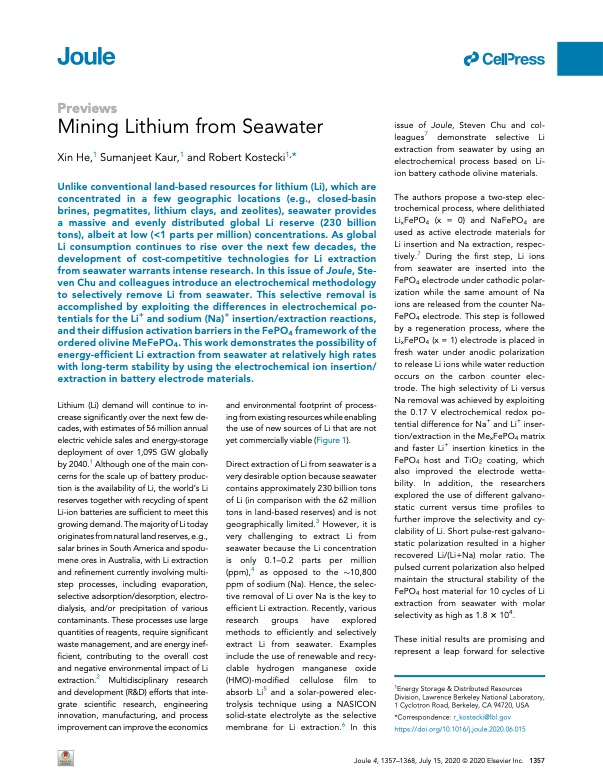
PDF Publication Title:
Text from PDF Page: 001
Previews Mining Lithium from Seawater Xin He,1 Sumanjeet Kaur,1 and Robert Kostecki1,* Unlike conventional land-based resources for lithium (Li), which are concentrated in a few geographic locations (e.g., closed-basin brines, pegmatites, lithium clays, and zeolites), seawater provides a massive and evenly distributed global Li reserve (230 billion tons), albeit at low (<1 parts per million) concentrations. As global Li consumption continues to rise over the next few decades, the development of cost-competitive technologies for Li extraction from seawater warrants intense research. In this issue of Joule, Ste- ven Chu and colleagues introduce an electrochemical methodology to selectively remove Li from seawater. This selective removal is accomplished by exploiting the differences in electrochemical po- tentials for the Li+ and sodium (Na)+ insertion/extraction reactions, and their diffusion activation barriers in the FePO4 framework of the ordered olivine MeFePO4. This work demonstrates the possibility of energy-efficient Li extraction from seawater at relatively high rates with long-term stability by using the electrochemical ion insertion/ extraction in battery electrode materials. issue of Joule, Steven Chu and col- leagues7 demonstrate selective Li extraction from seawater by using an electrochemical process based on Li- ion battery cathode olivine materials. The authors propose a two-step elec- trochemical process, where delithiated LixFePO4 (x = 0) and NaFePO4 are used as active electrode materials for Li insertion and Na extraction, respec- tively.7 During the first step, Li ions from seawater are inserted into the FePO4 electrode under cathodic polar- ization while the same amount of Na ions are released from the counter Na- FePO4 electrode. This step is followed by a regeneration process, where the LixFePO4 (x = 1) electrode is placed in fresh water under anodic polarization to release Li ions while water reduction occurs on the carbon counter elec- trode. The high selectivity of Li versus Na removal was achieved by exploiting the 0.17 V electrochemical redox po- tential difference for Na+ and Li+ inser- tion/extraction in the MexFePO4 matrix and faster Li+ insertion kinetics in the FePO4 host and TiO2 coating, which also improved the electrode wetta- bility. In addition, the researchers explored the use of different galvano- static current versus time profiles to further improve the selectivity and cy- clability of Li. Short pulse-rest galvano- static polarization resulted in a higher recovered Li/(Li+Na) molar ratio. The pulsed current polarization also helped maintain the structural stability of the FePO4 host material for 10 cycles of Li extraction from seawater with molar selectivity as high as 1.8 3 104. These initial results are promising and represent a leap forward for selective 1Energy Storage & Distributed Resources Division, Lawrence Berkeley National Laboratory, 1 Cyclotron Road, Berkeley, CA 94720, USA *Correspondence: r_kostecki@lbl.gov https://doi.org/10.1016/j.joule.2020.06.015 Lithium (Li) demand will continue to in- crease significantly over the next few de- cades, with estimates of 56 million annual electric vehicle sales and energy-storage deployment of over 1,095 GW globally by 2040.1 Although one of the main con- cerns for the scale up of battery produc- tion is the availability of Li, the world’s Li reserves together with recycling of spent Li-ion batteries are sufficient to meet this growing demand. The majority of Li today originates from natural land reserves, e.g., salar brines in South America and spodu- mene ores in Australia, with Li extraction and refinement currently involving multi- step processes, including evaporation, selective adsorption/desorption, electro- dialysis, and/or precipitation of various contaminants. These processes use large quantities of reagents, require significant waste management, and are energy inef- ficient, contributing to the overall cost and negative environmental impact of Li extraction.2 Multidisciplinary research and development (R&D) efforts that inte- grate scientific research, engineering innovation, manufacturing, and process improvement can improve the economics and environmental footprint of process- ing from existing resources while enabling the use of new sources of Li that are not yet commercially viable (Figure 1). Direct extraction of Li from seawater is a very desirable option because seawater contains approximately 230 billion tons of Li (in comparison with the 62 million tons in land-based reserves) and is not geographically limited.3 However, it is very challenging to extract Li from seawater because the Li concentration is only 0.1–0.2 parts per million (ppm),4 as opposed to the $10,800 ppm of sodium (Na). Hence, the selec- tive removal of Li over Na is the key to efficient Li extraction. Recently, various research groups have explored methods to efficiently and selectively extract Li from seawater. Examples include the use of renewable and recy- clable hydrogen manganese oxide (HMO)-modified cellulose film to absorb Li5 and a solar-powered elec- trolysis technique using a NASICON solid-state electrolyte as the selective membrane for Li extraction.6 In this ll Joule 4, 1357–1368, July 15, 2020 a 2020 Elsevier Inc. 1357PDF Image | Mining Lithium from Seawater

PDF Search Title:
Mining Lithium from SeawaterOriginal File Name Searched:
mining-lithium-from-seawater.pdfDIY PDF Search: Google It | Yahoo | Bing
Product and Development Focus for Salgenx
Redox Flow Battery Technology: With the advent of the new USA tax credits for producing and selling batteries ($35/kW) we are focussing on a simple flow battery using shipping containers as the modular electrolyte storage units with tax credits up to $140,000 per system. Our main focus is on the salt battery. This battery can be used for both thermal and electrical storage applications. We call it the Cogeneration Battery or Cogen Battery. One project is converting salt (brine) based water conditioners to simultaneously produce power. In addition, there are many opportunities to extract Lithium from brine (salt lakes, groundwater, and producer water).Salt water or brine are huge sources for lithium. Most of the worlds lithium is acquired from a brine source. It's even in seawater in a low concentration. Brine is also a byproduct of huge powerplants, which can now use that as an electrolyte and a huge flow battery (which allows storage at the source).We welcome any business and equipment inquiries, as well as licensing our flow battery manufacturing.| CONTACT TEL: 608-238-6001 Email: greg@salgenx.com | RSS | AMP |